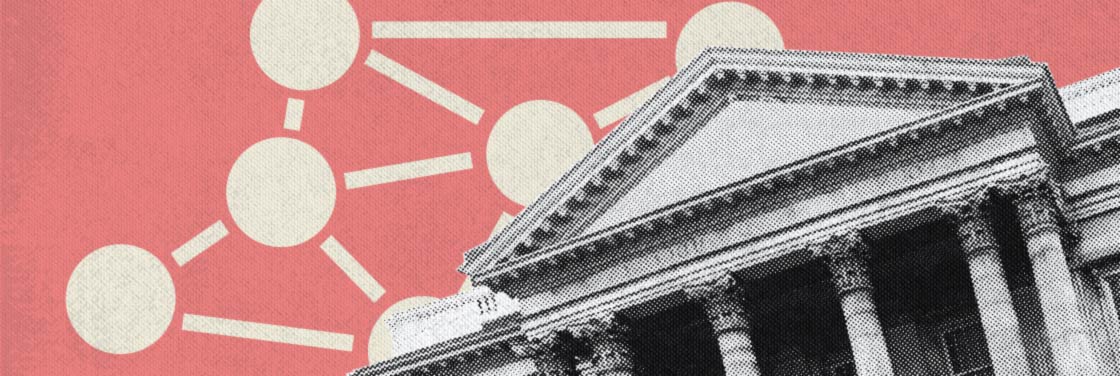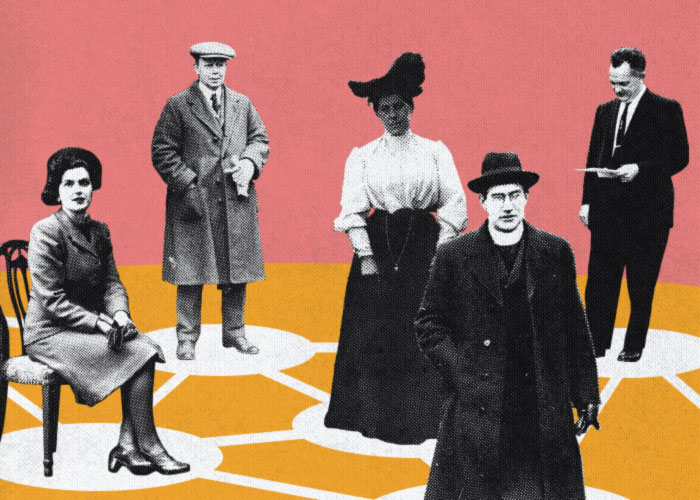With the introduction of distributed ledgers, blockchain, and smart contracts, new concepts based on them have emerged, and decentralized autonomous organizations (DAOs) are often referred to as the new way of community financial management. It’s worth taking a closer look at the applicability, benefits, threats, and vulnerabilities of DAOs and seeing if this concept is likely to find its place in the world of finance anytime soon.
Theory Embodied in Blockchain

Today the meaning of “DAO” is mostly associated with digital currencies, but in general, it is perceived as a method of digital collectivization – in other words, a way of having a structure around a business without a central authority. The system is controlled by the community according to predetermined principles, which are based on ideas proposed and agreed upon by the majority of its participants. The decision-making mechanism in DAOs is prescribed in advance; after that, the decisions are executed automatically, based on the specified parameters, be it a signing of a contract or participants’ voting. Members make proposals and vote on them for the future activity of a specific DAO. This includes such decisions as allocating resources and operations on a technical level.
Automation is built on the basis of smart contracts, which independently execute specified actions when certain conditions are met, e.g. when a proposal receives a majority of votes. Auto execution means that an individual or group cannot be responsible for task performance, they cannot influence or interfere with the process; the whole organization is responsible for everything. Smart contracts are transparent in the sense that they are available on a blockchain, which means they are publicly auditable and verifiable. All actions are recorded in a distributed ledger and cannot be altered or tampered with. Thus, smart contracts are the basis of an organization without a central authority, with a horizontal hierarchy, and whose members can be located anywhere in the world. Theoretically, everything looks flawless, but what are things like now in the real world?
DAO + Financial Institutions = ?

The potential impact of DAOs on traditional hierarchical institutions has been explored by researchers ranging from professors at the University of Miami to analysts at the VanEck investment group. In early 2023, WEF experts released a report called the Decentralized Autonomous Organization Toolkit, which provides a detailed analytical study of the phenomenon, as well as a set of recommendations on how to start a DAO and keep it running.
When it comes to combining the DAO with the financial system, experts cautiously note that decentralized organizations can either help restore confidence in the banking system, or vice versa, become one of the tools for its restructuring. Caria Wei, CEO and Co-Founder of NUVO, is sure that decentralized organizations can influence the market:
“DAOs have the potential to disrupt traditional banking institutions, especially those that are considered to be ‘tech-related’, as they offer an alternative model of financial organization and governance.”
According to Accenture’s global survey, by the end of 2020, consumer confidence in the banking system had fallen to 29%, down from 43% two years earlier. It’s still hard to imagine what this figure could look like in 2023, but current developments in the US and European financial markets don’t bode well. According to a study by EY, the banking landscape has changed in recent years and this process is still ongoing. 37% of consumers rank FinTech at the top of their list of “most trusted financial services”. At the same time, 51% of Gen Z and 49% of Millennials cited FinTech as the financial brand they trust most.
Today, FinTech is a pretty broad category that includes all sorts of technologies and solutions. DAOs fall into this category, providing financial institutions with a solution for asset management, compliance, and lending. There are many areas in finance where a DAO-based model can be useful:
- Fundraising, as well as providing loans and credit. DAOs can help in both attracting capital from a wide range of investors through digital asset offerings and providing credit tranches without the participation of an intermediary. DAOs provide safer ways to borrow money at lower interest rates and with better terms.
- Securities transactions. DAOs make it possible to issue, manage, and trade securities, both digital and traditional, and also through the tokenization of bonds, stocks, and other assets.
- KYC, fraud prevention, and risk management. Using smart contracts, financial players can automate customer acquisition and verification processes.
In a decentralized organization, the key aspect lies in its governance tokens, which empower stakeholders to make decisions through voting. Primarily, the proliferation of DAOs is closely linked to the rapid growth of the decentralized finance (DeFi) market, which is often managed precisely with the help of decentralized organizations. The most popular digital projects using this principle are Maker DAO, Aave, Uniswap, and Lido. One of the key elements of DAOs in digital finance is the “treasury”, a storage of assets on the blockchain, which is managed according to the same principles by which all decisions are made. In essence, it resembles the treasury of any traditional banking institution.
If we try to imagine the possibility of combining DAOs and traditional hierarchical structures – the implementation will not be an easy process, due to the difference in concepts. Most likely, the institution will still maintain some type of structure or hierarchy as required by law and regulations. DAOs can be organized around specific products or services. Even within a traditional institution such as a bank, the DAO structure still implies a certain level of decentralization that fairly distributes powers among all its members, and such a setup looks rather paradoxical. This may be the reason why traditional institutions have not yet found a way to apply the DAO model in their practice.
DAOs Today

Currently, experts count almost 6,000 active DAOs, and many of them are involved in financial transactions in one way or another. In many DAOs, community members buy the organization’s own tokens with fiat or digital assets to use those governance tokens to vote on proposals. Assets generated from the sale of tokens are allocated to fund activities related to the DAO or remain in the “treasury.”
Despite the generality of the principle, the purpose of every DAO can differ very much – it can be social support for the poor, the growth of a gaming guild, an educational platform, venture capital funding, etc. In 2022, the DeepDAO analytical platform classified 14 types of autonomous organizations, four of which were directly related to financial activities.
An interesting feature of a DAO may be the fact that the organization can change its purpose and may eventually end up with the characteristics of a financial organization. For example, the crypto project “Friends With Benefits” (FWB) was founded as a closed community in September 2020, based on an exclusive private membership system – a kind of offline-online social network with limited access for creative people in New York. However, after members established a DAO, the project began to gain momentum and went beyond just a community that existed without a specific purpose.
Members had to purchase $FWB tokens in order to participate in FWB decision-making. By developing a DAO and inviting new members and celebrities, FWB was able to raise investments totaling $10 million from companies such as Andreessen Horowitz, Pace Capital, and Li Jin. During the FWB DAO’s existence from 2020 to 2023, members launched an NFT gallery, a music studio, the FWB Cities project in the Metaverse, and several media projects – all actions and decisions were accepted through voting.
Eventually, it turns out that blockchain can help in establishing great conglomerates with various goals and purposes. If their activities require investments, they create their own management system, without resorting to mediators. In addition, DAOs that have been created for the purpose of operating in the financial markets already pose a certain degree of threat to traditional institutions in this sector.
One of the obstacles standing in the way of the development of DAOs is the uncertainty of the legal status. For example, in the United States, decentralized organizations are struggling for the right to be legalized – organizations have already applied and received approval in the state of Wyoming, but so far the Securities and Exchange Commission (SEC) has prevented this decision. Currently, the only jurisdiction that has officially legalized DAOs is the Marshall Islands, which allows them to be registered in the internationally recognized LLC (limited liability company) format.
However, the actual decentralized nature of the projects continues to break down when it comes face-to-face with reality. Chainalysis proved this by analyzing many large DAOs and eventually coming to an uncomfortable conclusion: up to 90% of the governance tokens are concentrated in the hands of 1% of the holders. There’s not even a whiff of decentralization here.
“In such a system, DAOs become subject to manipulation by big players, which can lead to the unfair distribution of funds and the violation of decentralization principles,” says Yan Krivonosov, founder of the Crypto Emergency project.
According to Yan, DAOs have great potential, but they require additional security and management measures to become a more efficient and reliable system. Right now, DAOs can be targeted by hackers, resulting in a loss of funds and project disruption. Also, manipulation and loss of control over how money is distributed will lead to the misuse of funds, fraud, and litigation. According to the founding members of Crypto Emergency, the current challenges are stopping them from implementing a DAO into the project so far.
Caria Wei is also confident that DAOs can be manipulated at the current level of their development. According to the expert, many developers are interested in creating a system that can be truly decentralized. As an example, Caria names NUVO’s reputation framework as an example of a solution that can address this flaw. It is designed to distribute decision-making authority based on reputation rather than token ownership alone. It allows community members to earn reputation points based on their contributions and involvement in the DAO, which in turn influences their voting power. This approach can help ensure that decision-making in DAOs is more inclusive and representative of the broader community, mitigating the concentration of power, and enhancing the democratic nature of DAO governance.
What’s Next for DAOs?

Given that DAOs are a concept mostly implemented in the crypto market, we can hardly expect rapid growth and development of such organizations at the moment. However, recently published data from DeepDAO reports that the total assets of all decentralized autonomous organizations have already surpassed $25.6 billion. Yes, it looks like a drop in the ocean of the huge financial system, but it’s also the first remarkable milestone in a long journey.
It is worth keeping in mind that the unfolding banking crisis in the U.S. and Europe is forcing people and organizations to look for alternative ways to store and operate their finances. This year may well present us with a new round of DAO development – it all depends on the tectonic changes in the global financial market, which are already in full swing.




